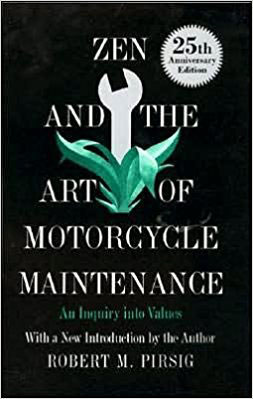|
|
|
|
The Down to Earth Woodworker
By Steven D. Johnson
Racine, Wisconsin
|
|
This Month's Column:
•
Zen And The Art Of Tractor Maintenance
•
Etsy & The Copper Post Top Story
•
Roller Stands / Portable Work Supports
Zen And The Art Of Tractor Maintenance
Click on any picture to see a larger version.

|
Figure 1 - Not just a mid-70's hippie treatise,
but a fascinating exploration of the term
"quality" --- recommended reading if you
haven't already!
|
If this were to be a remake or take-off on "Zen And The Art Of Motorcycle Maintenance," I would be the John Sutherland character, not the author. For proof, one only would need to go back to my
February 2015 column
where I was once dreaming of a mobile woodworking equipment service team that would visit my shop, tune up my equipment, replace worn parts, and apply oil and grease. It wasn't laziness or ineptitude, it was my fully romanticized vision of woodworking without interruption via the mundane activities of sharpening, oiling, tightening, and adjusting.
Like woodworking machinery, tractors require maintenance. And just as it is impractical to pick up a cabinet saw, jointer, or planer and take it to a shop for routine maintenance, it is cumbersome and expensive to take a tractor to a dealership for service work. Thus, it is better to be Robert Pirsig than John Sutherland, but perhaps even more importantly, to meld the two into a gestalt-loving romantic realist. I'm working on it.
I don't love sharpening chisels, plane irons, and carving tools. I don't love grease fittings, oil filters, and torque wrenches, either. I have learned to sharpen quickly so I can get back to woodworking. I am learning to maintain my tractor for the same reason. But could I learn to love sharpening? Could I learn to love grease, oil, and socket wrenches? Could I learn to love the maintenance as much as the ride, like the motorcycle-maintenance guru Robert Pirsig? Tough, but I'm working on it.
At the table saw, I can intuit when a blade needs to be cleaned, when a trip to the factory for sharpening is in order, and when the blade simply needs to be tossed into the recycling bin and a new one needs to be installed. I know when a battery in a portable tool is nearing depletion. I don't need a fuel gauge to tell me. I can tell when the square chisel and bit in my mortising machine needs a squirt of lubricant or needs to cool a bit before the next plunge cut. Without thinking, I know when to stop and touch up the edge of my jack plane's iron. I can "sense" these things because I am familiar, in fact I am "one," with the tool. But how did I get that way?
Turns out, it is from performing the very tasks I am so loath to do. Sharpening gives me tactile feedback of the before and after of the blade. Cleaning a table saw blade changes the sound, the feel, and even the smell of the cut wood. The downforce on a mortising chisel changes, as does the sound, with lubrication, and my previous research into rechargeable batteries gave me insight into the impact declining voltage has on even the most sophisticated brushless DC motors.
Likewise, pumping grease into the eight fittings on the front end loader of my tractor gave me immediate feedback. I was scooping up buckets full of gravel and transporting it to a job site… some 65 loads in all. Stopping halfway through and giving a shot of grease to all the joints and knuckles on the loader allowed me to better "feel" the lift and curl functions through the control levers.
There is a rationale to tool maintenance and a romanticism to tool use. Melding rationale and romanticism is my goal. Can I learn to enjoy tool and equipment maintenance? Only if I live each moment of the maintenance portion of the woodworking (and tractor) experience with the same enthusiasm and zeal as I do in their use. To do so requires a prescriptive (rational) self-control while allowing my mind to enter a Zen-like (romantic) oneness with the task. Sounds a bit like gobbledy-gook, but it is not.
With hands moving a plane blade, a wet stone underneath, one can feel the junction of the bevel to the flat back, can feel the resistance or lack thereof on the stone, and can, in time, even feel the imperfections that might show only under a magnifying glass and a strong light. Continuing to stroke the blade changes the feel perceptibly. It is entirely possible to reach a state of being able to "feel" the sharpness of the blade by feeling the blade on the stone… no need to look or test, it will "feel" right.
Over time it is also quite likely possible to "feel" 50 pounds of torque when tightening a nut, without the use of a torque wrench… to know exactly when grease will begin to ooze out the other side of a grease fitting… to hear a straining hydraulic pump, to sense the temperature of the radiator. It is, after all, entirely possible to tell from the sound of a spinning blade when to clean, sharpen, or replace. It is all about viewing the maintenance as an enjoyable pursuit rather than a task to hurry through.
(Page 1 of 3)
1
2
3
Next Page

Steven Johnson is retired from an almost 30-year career selling medical equipment and supplies, and now enjoys improving his shop, his skills, and his designs on a full time basis (although he says home improvement projects and furniture building have been hobbies for most of his adult life). Steven can be reached directly via email at
sjohnson@downtoearthwoodworking.com
Return to the
Wood News Online
front page
|
|
|
|
|